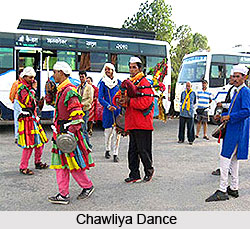 Chawliya Dance is a form of folk dance of the performed by the males and the females of the Tehri-Garhwal region. It is a sort of `sword` dance which is danced with the accompaniment of the `Dholak`, `Kansi` and flutes. The male dancers brandish their swords and dance with light steps. With time the rhythm of their movement becomes faster and they whirl around speedily. The womenfolk also dance with quick footsteps. Sometimes the women are placed between two men who hold them by their waists, and the women swing while singing and dancing. The dance form portrays the idea of defending the women and property from outsiders.
Chawliya Dance is a form of folk dance of the performed by the males and the females of the Tehri-Garhwal region. It is a sort of `sword` dance which is danced with the accompaniment of the `Dholak`, `Kansi` and flutes. The male dancers brandish their swords and dance with light steps. With time the rhythm of their movement becomes faster and they whirl around speedily. The womenfolk also dance with quick footsteps. Sometimes the women are placed between two men who hold them by their waists, and the women swing while singing and dancing. The dance form portrays the idea of defending the women and property from outsiders.
The song depicts a novel idea which narrates the slaughter of a demon while trying to kill a new-born baby in the village. The dance recalls the episode of the killing of the demon `Kansa` by Lord Krishna.
Dress of Chawliya Dance
The dresses of the performers of the Chawliya Dance are very impressive. The male performers wear white long and loose robes like `Achkan` that extend up to the heels. The garments that they wear are usually full-sleeved with tied strings on the chest. There are coloured pieces of spades, hearts, clubs and diamonds designed on the shoulders, back and chest. The performers sometimes put on either white turbans or white caps. The male performers wear tight-fitting` `Pyjamas` up to the heels.
The female performers wear white `Lahangas` frilled at the bottom. On top they wear full-sleeved deep green or deep blue velvet jackets that extend up to the knees. The performers also adorn themselves with silver necklaces having big and heavy pendants at the middle and silver beads all around. The necklace is studded with silver coin-like pieces. They also put huge nose rings which remains hung down with small silver beads almost covering the mouth and the chin. The womenfolk also wear large and heavy bangles and ear-rings. Their head remains veiled and occasionally the head-dress is made of a silver chain worn around the head. The dancers do not prefer wearing anklets.
The women dance with brass plates balancing them on their fingers and revolving them speedily. The dancers form a circle holding each others hand and bending forward. They step forward and backward while singing their melodious songs in chorus.



















